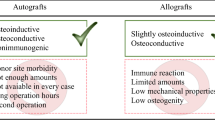Abstract
The efficacy of a total hip replacement with a hydroxyapatite-coated hip prosthesis was compared with that of an uncoated, cementless prosthesis of the same type. Preoperatively, there was no difference in the patient's diagnosis, hip score, age, and sex. All operations were performed by one surgeon in a standardized manner. The choice of the implant was randomized, and the follow-up period was equal for both types. The implant used was associated with a poor outcome due to a high incidence of early aseptic loosening. Probably because of a poor initial fixation, there was a significant difference in the clinical results after a short follow-up period when an additional HA layer was used. According to the patients' pain, migration of the implant, and presence of a progressive radiolucent line, use of the HA-coated prosthesis led to a significantly better result; however, we also found an increased rate of heterotopic bone formation in the HA-coated group. It was concluded that the HA coating improves the initial fixation of a hip prosthesis.
Similar content being viewed by others
References
Apel DM, Smith DG, Schwarz CM, Paporsky WG (1989) Threaded cup acetabuloplasty. Early clinical experience. Clin Orthop 241:183–189
Bauer R, Kerschbaumer F, Poisel S (1989) Operative Zugänge in Orthopädie und Traumatologie. Springer, Berlin Heidelberg New York
Brooker AF, Bowermann JW, Robinson RA, Riley LH (1973) Ectopic ossification following total hip replacement. J Bone Joint Surg [Am] 55:1629–1632
Callaghan JJ, Dysart SH, Savory CG (1988) The uncemented PCA total hip prosthesis. Two-year results of a prospective consecutive series. J Bone Joint Surg 70:337–346
Campbell ACL, Rorabeck CH, Bourne RB, Chess D, Nott L (1992) Thigh pain after cementless hip arthroplasty: annoyance or ill omen. J Bone Joint Surg [Br] 74:63–66
Cornell CN, Ranawat CS (1986) Survivorship analysis of total hip replacements. Results in a series of patients who were less than fifty-five years old. J Bone Joint Surg [Am] 68:1430–1434
D'Antonio JA, Capello WN, Jaffe WL (1992) Early clinical experience with hydroxyapatite-coated femoral implants. J Bone Joint Surg [Am] 74:995–1008
Dorr LD, Smith C (1992) Clinical results from the calcitite-coated press fit APR hip system. Dent Clin North Am 36:239–246
Engh CA, Bobyn JD, Glassman AH (1987) Porous-coated hip replacement. The factors governing bone ingrowth, stress shielding, and clinical results. J Bone Joint Surg [Br] 69:45–55
Furlong RJ, Osborn JF (1991) Fixation of hip prosthesis by hydroxyapatite ceramic coatings. J Bone Joint Surg [Br] 73:741–745
Geesink GT (1990) Hydroxyapatite-coated total hip prostheses: two-year clinical and roentgenographic results of 100 cases. Clin Orthop 261:39–58
Geesink GT, Soballe K, Rasmussen RB (1989) Early fixation of allogenic bone graft in titanium and hydroxyl-apatite coated implants. Trans Orthop Res Soc 14:554
Hardy DCR, Frayssinet P, Guilhem A, Lafontaine MA, Delince PE (1991) Bonding of hydroxyapatite-coated femoral prostheses: histopathology of specimens from four cases. J Bone Joint Surg [Br] 73:732–740
Harris WH (1969) Traumatic arthritis of the hip after dislocation and acetabular fractures: treatment by mold arthroplasty. An end-result study using a new method of result evaluation. J Bone Joint Surg [Am] 51:737–755
Harris WH, White RE (1982) Socket fixation using a metalbacked acetabular component for total rip replacement. A minimum five years follow-up. J Bone Joint Surg [Am] 64:745–748
Hedley AK, Gruen TA, Borden LS, Hungerford DS, Habermann E, Kenna RV (1987) Two-year follow-up of the PCA noncemented total hip replacement. Hip, pp 225–250
Johnston RC, Fitzgerald RH, Harris WH, Poss R, Müller ME, Sledge CB (1990) Clinical and radiographic evaluation of total hip replacement: a standard system of terminology for reporting results. J Bone Joint Surg [Am] 72:161–168
Maloney WJ, Harris WH (1990) Comparison of a hybrid with an uncemented total hip replacement. J Bone Joint Surg [Am] 72:1349–1352
Mecron (c) hip prostheses. Die Hydroxylapatit-beschichtete Hüftprothese. Die Bioprothese der III. Generation. Pantomed Lucerne, Switzerland
Mikic S, Pfirrmann RW (1990) Die Hydroxylapatit-beschichtete Totalprothese der Hüfte. Zentralbl Chir 115:695–705
More RC, Amstutz HC, Kabo JM, Dorey FJ, Moreland JR (1992) Acetabular reconstruction with a threaded prosthesis for failed total hip arthroplasty. Clin Orthop 282:114–122
Oonishi H (1991) Orthopaedic applications of hydroxyapatite. Biomaterials 12:171–178
Osborn JF (1987) Die biologische Leistung der Hydroxylapatitkeramik-Beschichtung auf dem Femurschaft einer Titanendoprothese — erste histologische Auswertung eines Humanexplantates. Biomed Tech 32:177–183
Phillips TW, Messieh SS (1988) Cementless hip replacement for arthritis: problems with a smooth surface moore stem. J Bone Joint Surg [Br] 70:750–755
Ritter MA, Keating EM, Faris PM, Brugo G (1990) Metal-backed acetabular cups in total hip arthroplasty. J Bone Joint Surg [Am] 72:672–677
Vaughn BK, Lombardi AV, Mallory TH (1992) Clinical and radiographic experience with a hydroxyapatite-coated titanium plasma-sprayed porous implant. Dent Clin North Am 36:263–272
Wicki O, Mikic S, Gerber P (1990) Die mit Hydroxylapatit beschichtete Totalprothese der Hüfte. Helv Chir Acta 57:107–115
Wixson RL, Stulberg SD, Mehlhoff M (1991) Total hip replacement with cemented, uncemented, and hybrid prosthesia: a comparison of clinical and radiographic results at two to four years. J Bone Joint Surg [Am] 73:257–270
Wu HS, Chang JK, Lin SY (1991) Clinical experience in threaded-in cup acetabuloplasty. Kao-Hsiung-I-Hsueh-KoHsueh-Tsa-Chih 7:419–428
Author information
Authors and Affiliations
Rights and permissions
About this article
Cite this article
Huracek, J., Spirig, P. The effect of hydroxyapatite coating on the fixation of hip prostheses. Arch Orthop Trauma Surg 113, 72–77 (1994). https://doi.org/10.1007/BF00572908
Received:
Issue Date:
DOI: https://doi.org/10.1007/BF00572908




